IMAT5211 E-Commerce Systems: Business Model Analysis at DMU, UK
VerifiedAdded on 2023/04/11
|13
|2554
|61
Report
AI Summary
This report presents a comprehensive business analysis of De Montfort University's e-commerce systems, focusing on expanding international student enrollment through distance learning. It includes a SWOT analysis identifying strengths, weaknesses, opportunities, and threats related to DMU's distance learning marketplace, along with recommendations for improvement. The report also applies Porter's Five Forces model to assess the competitive landscape, considering factors like competitive rivalry, the threat of new entrants and substitutes, and the bargaining power of suppliers and buyers (students). Furthermore, it outlines objectives, critical success factors, and performance indicators for e-learning implementation, addressing cultural and trust issues in online learning environments. The analysis emphasizes the importance of institutional support, course development, student support, and effective online communication strategies to reach target audiences and maintain a strong reputation.
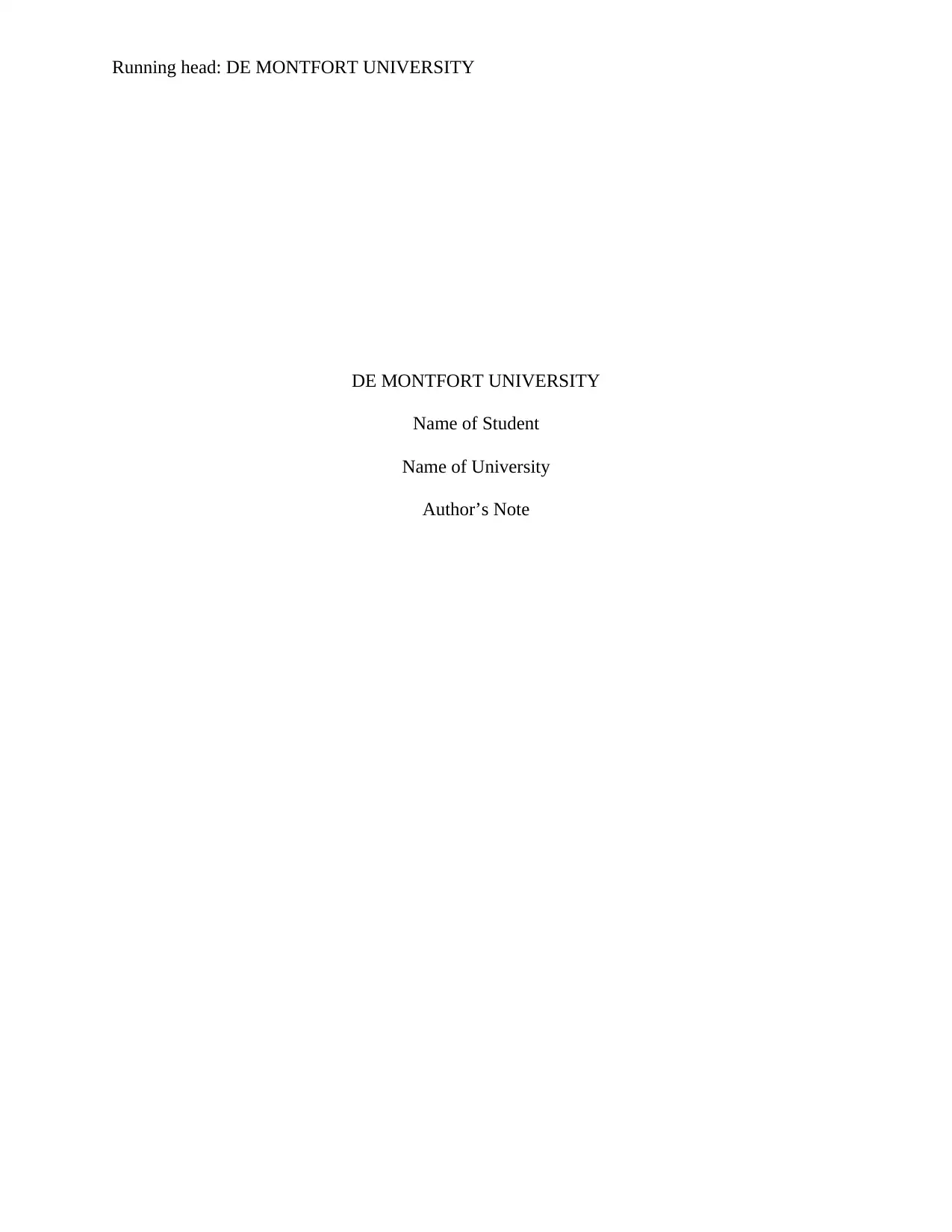
Running head: DE MONTFORT UNIVERSITY
DE MONTFORT UNIVERSITY
Name of Student
Name of University
Author’s Note
DE MONTFORT UNIVERSITY
Name of Student
Name of University
Author’s Note
Paraphrase This Document
Need a fresh take? Get an instant paraphrase of this document with our AI Paraphraser
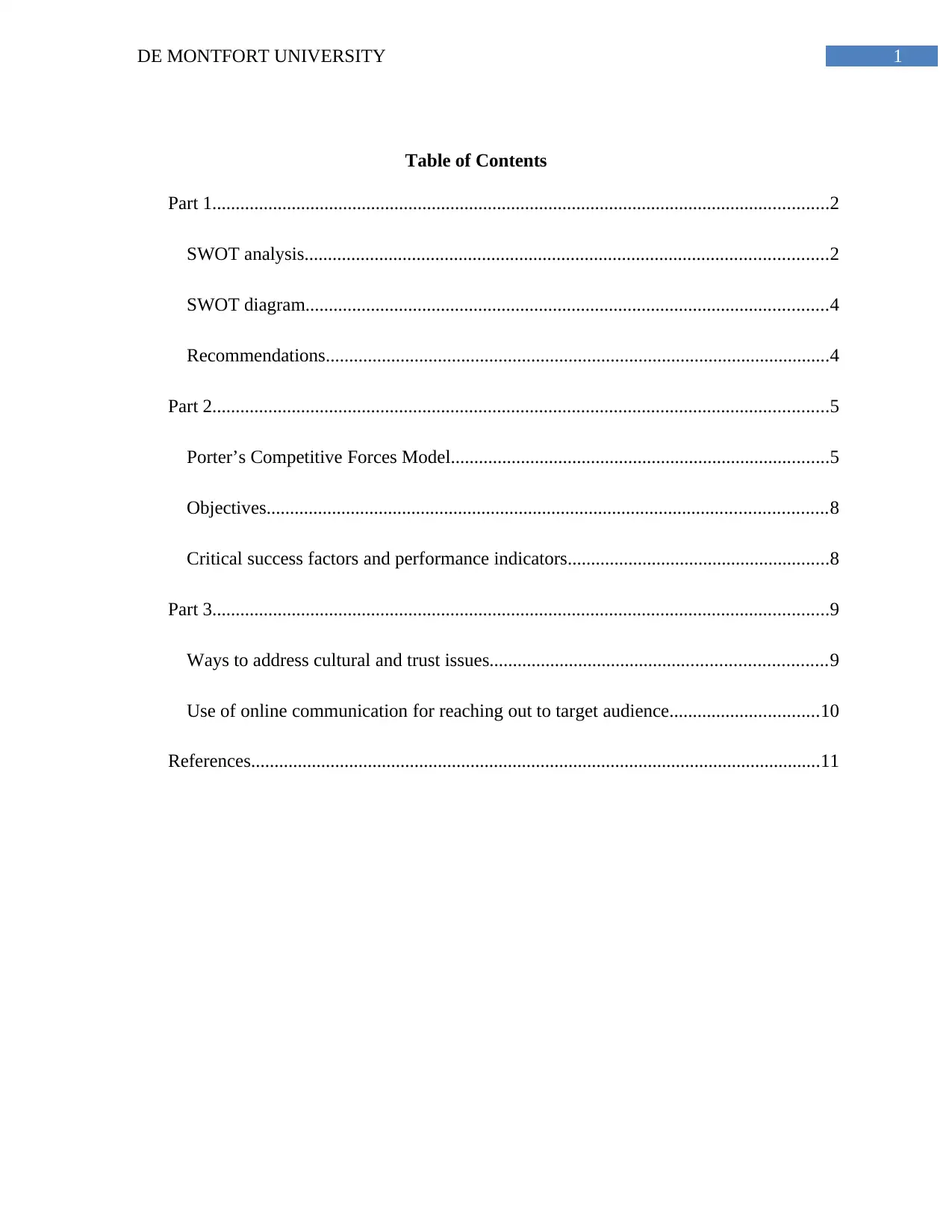
1DE MONTFORT UNIVERSITY
Table of Contents
Part 1....................................................................................................................................2
SWOT analysis................................................................................................................2
SWOT diagram................................................................................................................4
Recommendations............................................................................................................4
Part 2....................................................................................................................................5
Porter’s Competitive Forces Model.................................................................................5
Objectives........................................................................................................................8
Critical success factors and performance indicators........................................................8
Part 3....................................................................................................................................9
Ways to address cultural and trust issues........................................................................9
Use of online communication for reaching out to target audience................................10
References..........................................................................................................................11
Table of Contents
Part 1....................................................................................................................................2
SWOT analysis................................................................................................................2
SWOT diagram................................................................................................................4
Recommendations............................................................................................................4
Part 2....................................................................................................................................5
Porter’s Competitive Forces Model.................................................................................5
Objectives........................................................................................................................8
Critical success factors and performance indicators........................................................8
Part 3....................................................................................................................................9
Ways to address cultural and trust issues........................................................................9
Use of online communication for reaching out to target audience................................10
References..........................................................................................................................11
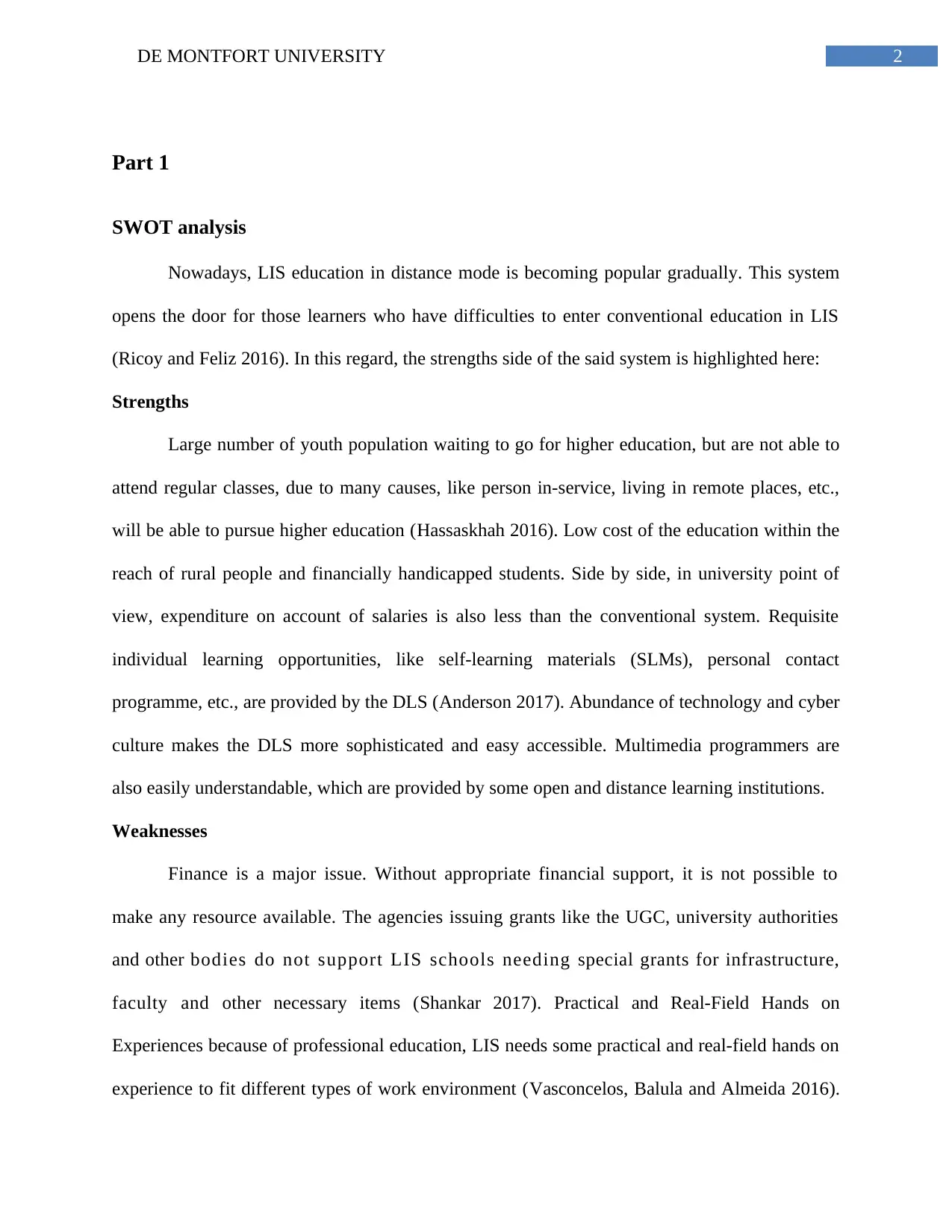
2DE MONTFORT UNIVERSITY
Part 1
SWOT analysis
Nowadays, LIS education in distance mode is becoming popular gradually. This system
opens the door for those learners who have difficulties to enter conventional education in LIS
(Ricoy and Feliz 2016). In this regard, the strengths side of the said system is highlighted here:
Strengths
Large number of youth population waiting to go for higher education, but are not able to
attend regular classes, due to many causes, like person in-service, living in remote places, etc.,
will be able to pursue higher education (Hassaskhah 2016). Low cost of the education within the
reach of rural people and financially handicapped students. Side by side, in university point of
view, expenditure on account of salaries is also less than the conventional system. Requisite
individual learning opportunities, like self-learning materials (SLMs), personal contact
programme, etc., are provided by the DLS (Anderson 2017). Abundance of technology and cyber
culture makes the DLS more sophisticated and easy accessible. Multimedia programmers are
also easily understandable, which are provided by some open and distance learning institutions.
Weaknesses
Finance is a major issue. Without appropriate financial support, it is not possible to
make any resource available. The agencies issuing grants like the UGC, university authorities
and other bodies do not support LIS schools needing special grants for infrastructure,
faculty and other necessary items (Shankar 2017). Practical and Real-Field Hands on
Experiences because of professional education, LIS needs some practical and real-field hands on
experience to fit different types of work environment (Vasconcelos, Balula and Almeida 2016).
Part 1
SWOT analysis
Nowadays, LIS education in distance mode is becoming popular gradually. This system
opens the door for those learners who have difficulties to enter conventional education in LIS
(Ricoy and Feliz 2016). In this regard, the strengths side of the said system is highlighted here:
Strengths
Large number of youth population waiting to go for higher education, but are not able to
attend regular classes, due to many causes, like person in-service, living in remote places, etc.,
will be able to pursue higher education (Hassaskhah 2016). Low cost of the education within the
reach of rural people and financially handicapped students. Side by side, in university point of
view, expenditure on account of salaries is also less than the conventional system. Requisite
individual learning opportunities, like self-learning materials (SLMs), personal contact
programme, etc., are provided by the DLS (Anderson 2017). Abundance of technology and cyber
culture makes the DLS more sophisticated and easy accessible. Multimedia programmers are
also easily understandable, which are provided by some open and distance learning institutions.
Weaknesses
Finance is a major issue. Without appropriate financial support, it is not possible to
make any resource available. The agencies issuing grants like the UGC, university authorities
and other bodies do not support LIS schools needing special grants for infrastructure,
faculty and other necessary items (Shankar 2017). Practical and Real-Field Hands on
Experiences because of professional education, LIS needs some practical and real-field hands on
experience to fit different types of work environment (Vasconcelos, Balula and Almeida 2016).
⊘ This is a preview!⊘
Do you want full access?
Subscribe today to unlock all pages.

Trusted by 1+ million students worldwide
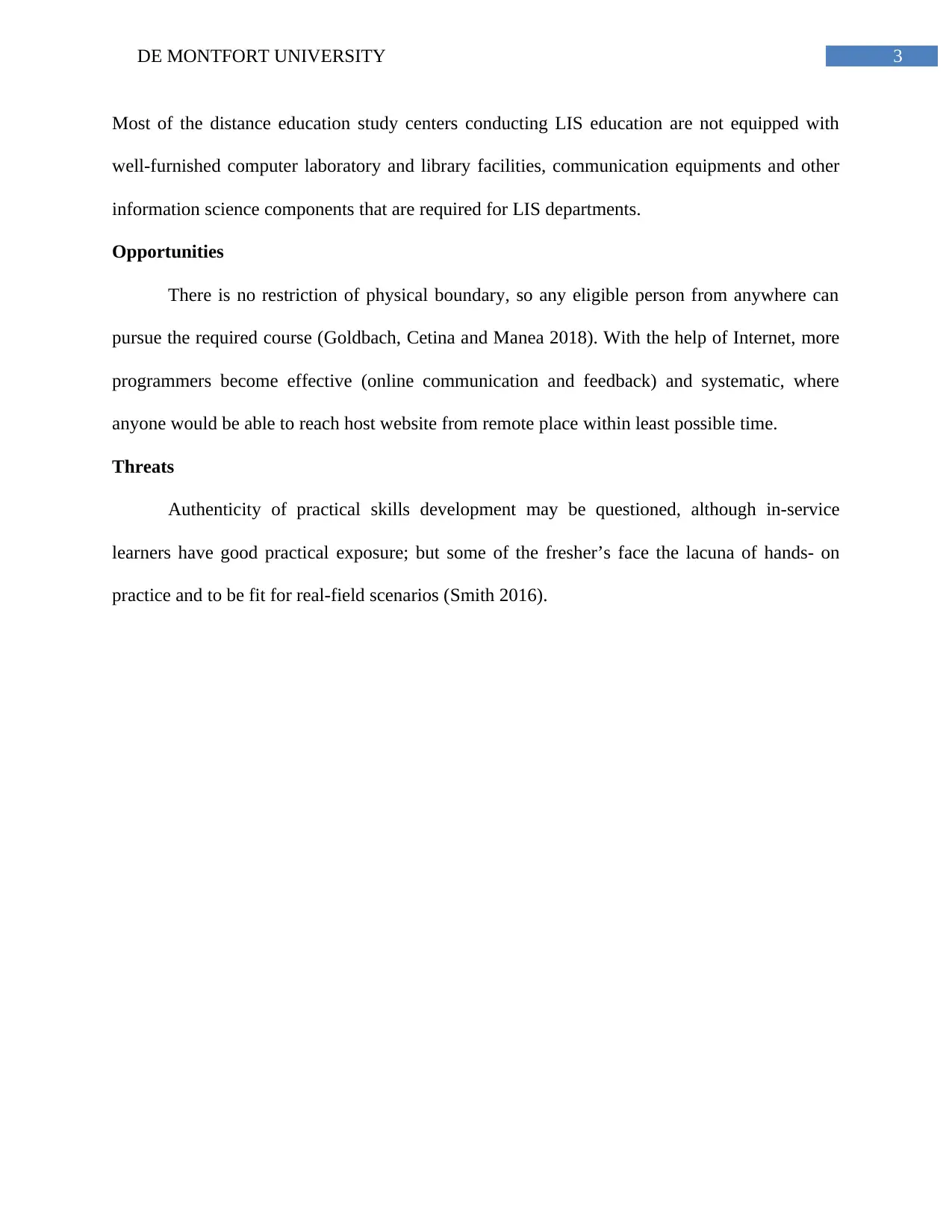
3DE MONTFORT UNIVERSITY
Most of the distance education study centers conducting LIS education are not equipped with
well-furnished computer laboratory and library facilities, communication equipments and other
information science components that are required for LIS departments.
Opportunities
There is no restriction of physical boundary, so any eligible person from anywhere can
pursue the required course (Goldbach, Cetina and Manea 2018). With the help of Internet, more
programmers become effective (online communication and feedback) and systematic, where
anyone would be able to reach host website from remote place within least possible time.
Threats
Authenticity of practical skills development may be questioned, although in-service
learners have good practical exposure; but some of the fresher’s face the lacuna of hands- on
practice and to be fit for real-field scenarios (Smith 2016).
Most of the distance education study centers conducting LIS education are not equipped with
well-furnished computer laboratory and library facilities, communication equipments and other
information science components that are required for LIS departments.
Opportunities
There is no restriction of physical boundary, so any eligible person from anywhere can
pursue the required course (Goldbach, Cetina and Manea 2018). With the help of Internet, more
programmers become effective (online communication and feedback) and systematic, where
anyone would be able to reach host website from remote place within least possible time.
Threats
Authenticity of practical skills development may be questioned, although in-service
learners have good practical exposure; but some of the fresher’s face the lacuna of hands- on
practice and to be fit for real-field scenarios (Smith 2016).
Paraphrase This Document
Need a fresh take? Get an instant paraphrase of this document with our AI Paraphraser
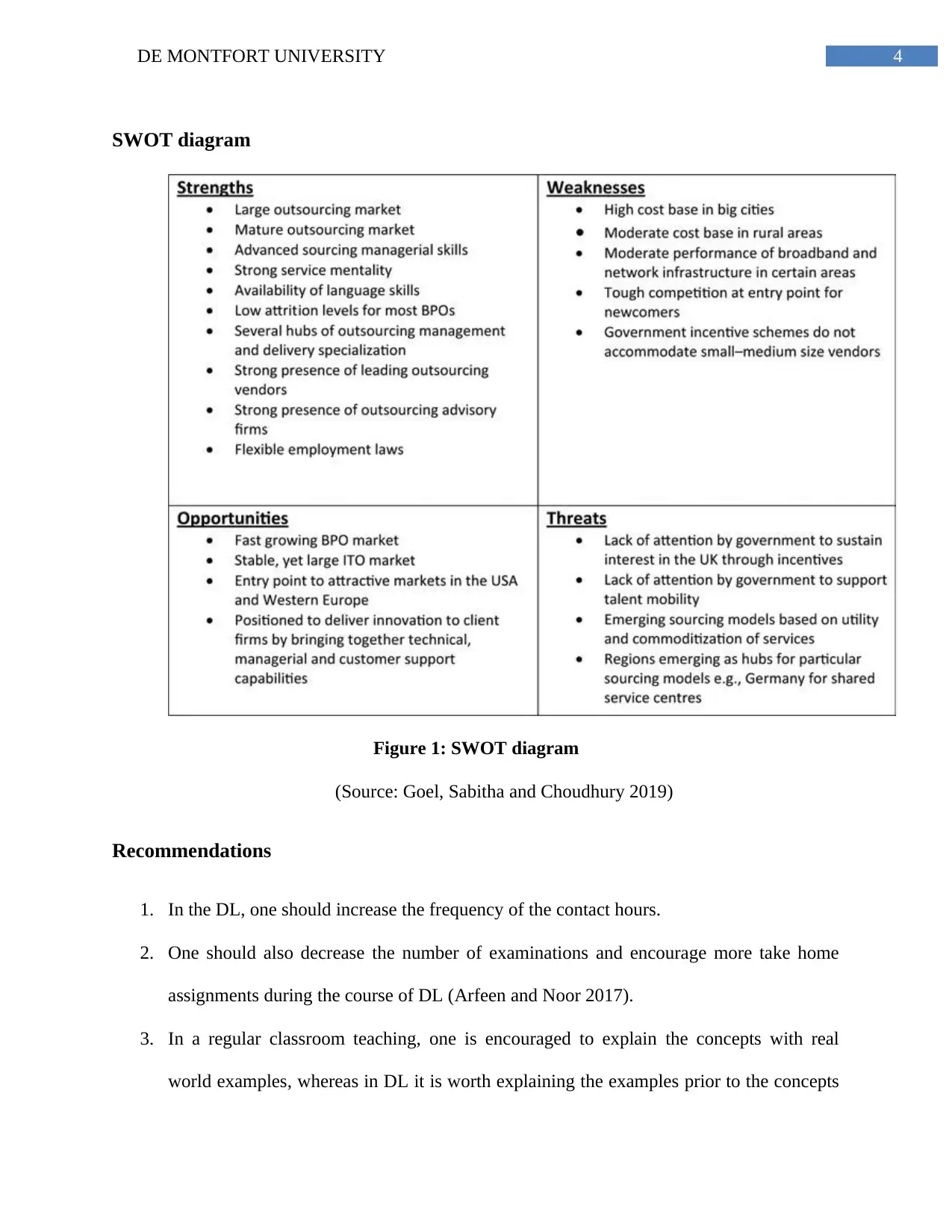
4DE MONTFORT UNIVERSITY
SWOT diagram
Figure 1: SWOT diagram
(Source: Goel, Sabitha and Choudhury 2019)
Recommendations
1. In the DL, one should increase the frequency of the contact hours.
2. One should also decrease the number of examinations and encourage more take home
assignments during the course of DL (Arfeen and Noor 2017).
3. In a regular classroom teaching, one is encouraged to explain the concepts with real
world examples, whereas in DL it is worth explaining the examples prior to the concepts
SWOT diagram
Figure 1: SWOT diagram
(Source: Goel, Sabitha and Choudhury 2019)
Recommendations
1. In the DL, one should increase the frequency of the contact hours.
2. One should also decrease the number of examinations and encourage more take home
assignments during the course of DL (Arfeen and Noor 2017).
3. In a regular classroom teaching, one is encouraged to explain the concepts with real
world examples, whereas in DL it is worth explaining the examples prior to the concepts
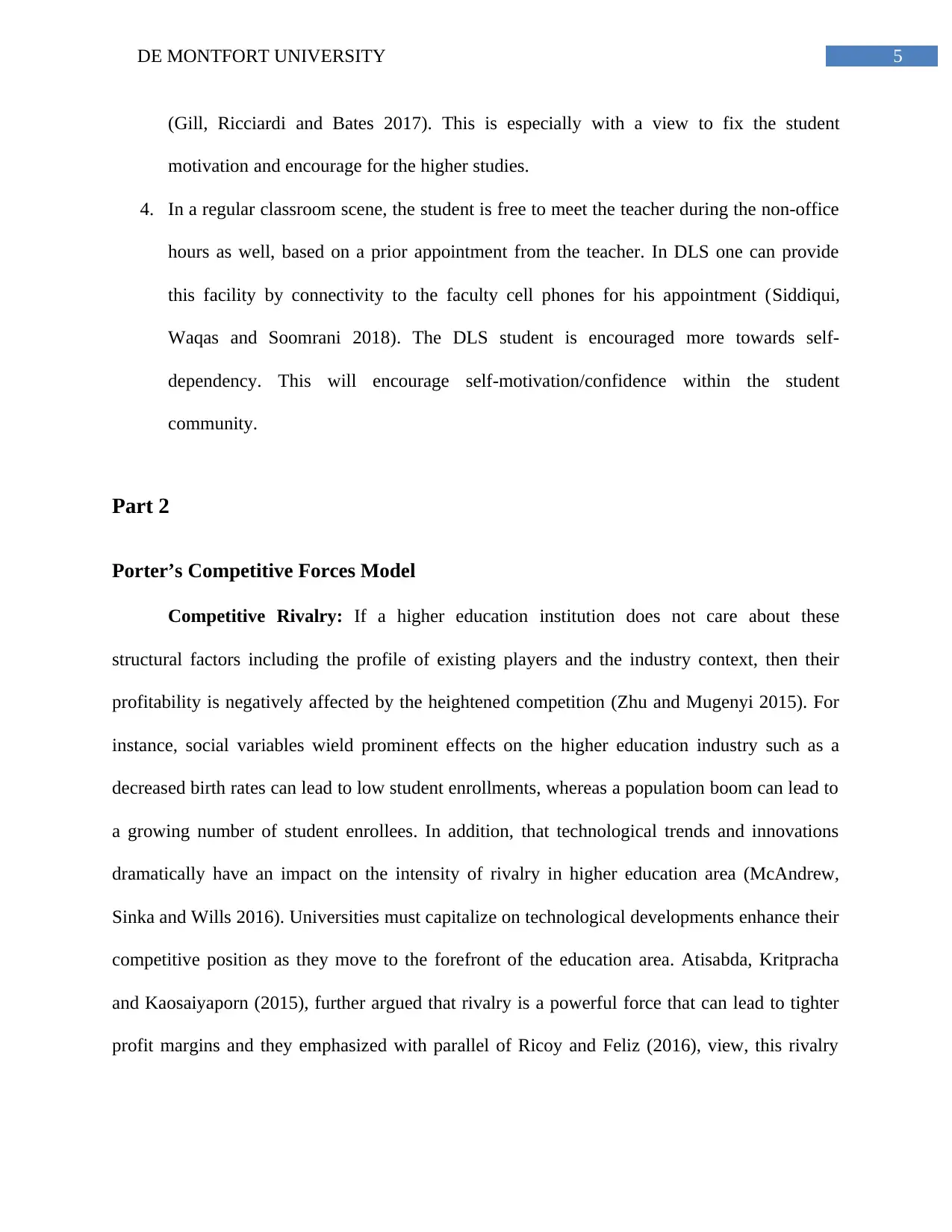
5DE MONTFORT UNIVERSITY
(Gill, Ricciardi and Bates 2017). This is especially with a view to fix the student
motivation and encourage for the higher studies.
4. In a regular classroom scene, the student is free to meet the teacher during the non-office
hours as well, based on a prior appointment from the teacher. In DLS one can provide
this facility by connectivity to the faculty cell phones for his appointment (Siddiqui,
Waqas and Soomrani 2018). The DLS student is encouraged more towards self-
dependency. This will encourage self-motivation/confidence within the student
community.
Part 2
Porter’s Competitive Forces Model
Competitive Rivalry: If a higher education institution does not care about these
structural factors including the profile of existing players and the industry context, then their
profitability is negatively affected by the heightened competition (Zhu and Mugenyi 2015). For
instance, social variables wield prominent effects on the higher education industry such as a
decreased birth rates can lead to low student enrollments, whereas a population boom can lead to
a growing number of student enrollees. In addition, that technological trends and innovations
dramatically have an impact on the intensity of rivalry in higher education area (McAndrew,
Sinka and Wills 2016). Universities must capitalize on technological developments enhance their
competitive position as they move to the forefront of the education area. Atisabda, Kritpracha
and Kaosaiyaporn (2015), further argued that rivalry is a powerful force that can lead to tighter
profit margins and they emphasized with parallel of Ricoy and Feliz (2016), view, this rivalry
(Gill, Ricciardi and Bates 2017). This is especially with a view to fix the student
motivation and encourage for the higher studies.
4. In a regular classroom scene, the student is free to meet the teacher during the non-office
hours as well, based on a prior appointment from the teacher. In DLS one can provide
this facility by connectivity to the faculty cell phones for his appointment (Siddiqui,
Waqas and Soomrani 2018). The DLS student is encouraged more towards self-
dependency. This will encourage self-motivation/confidence within the student
community.
Part 2
Porter’s Competitive Forces Model
Competitive Rivalry: If a higher education institution does not care about these
structural factors including the profile of existing players and the industry context, then their
profitability is negatively affected by the heightened competition (Zhu and Mugenyi 2015). For
instance, social variables wield prominent effects on the higher education industry such as a
decreased birth rates can lead to low student enrollments, whereas a population boom can lead to
a growing number of student enrollees. In addition, that technological trends and innovations
dramatically have an impact on the intensity of rivalry in higher education area (McAndrew,
Sinka and Wills 2016). Universities must capitalize on technological developments enhance their
competitive position as they move to the forefront of the education area. Atisabda, Kritpracha
and Kaosaiyaporn (2015), further argued that rivalry is a powerful force that can lead to tighter
profit margins and they emphasized with parallel of Ricoy and Feliz (2016), view, this rivalry
⊘ This is a preview!⊘
Do you want full access?
Subscribe today to unlock all pages.

Trusted by 1+ million students worldwide
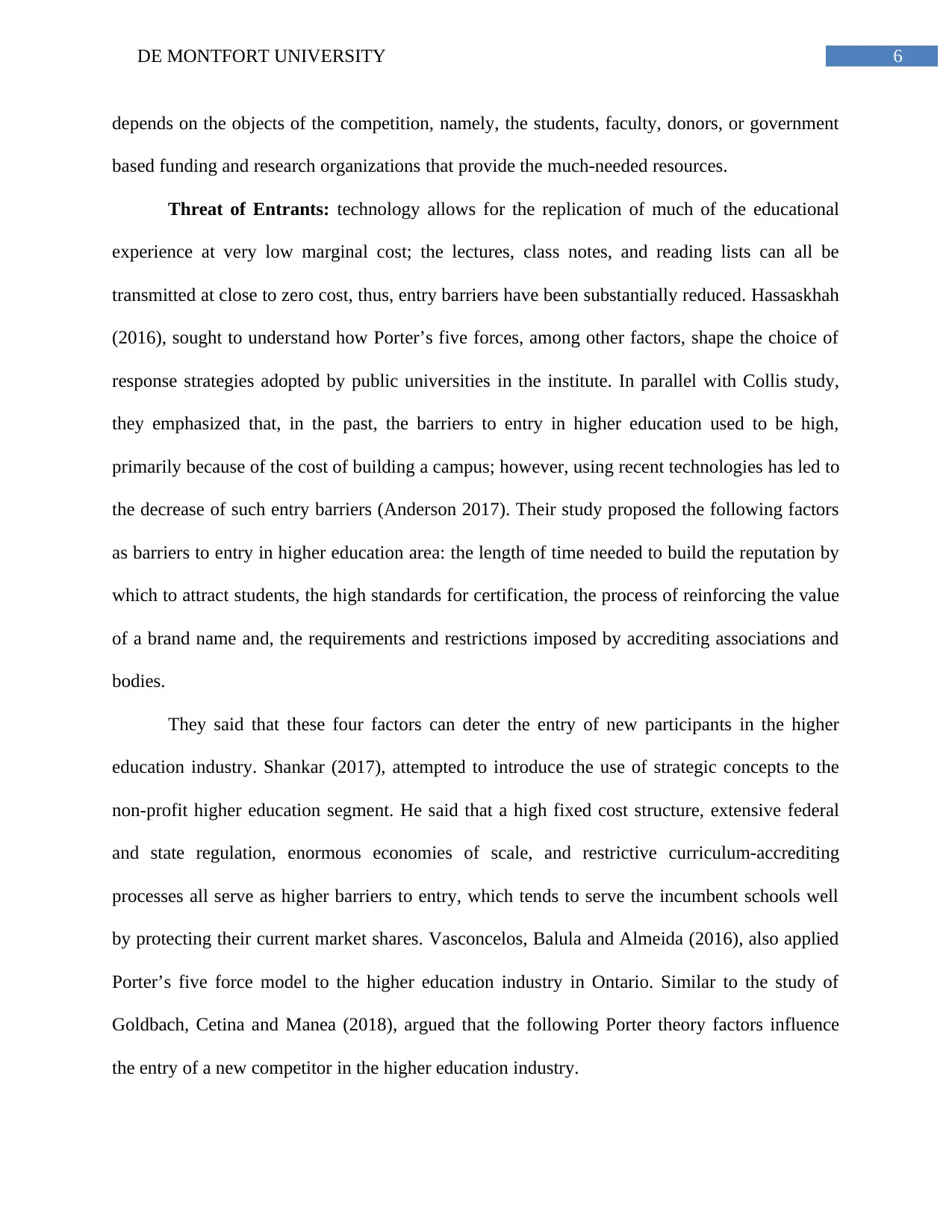
6DE MONTFORT UNIVERSITY
depends on the objects of the competition, namely, the students, faculty, donors, or government
based funding and research organizations that provide the much-needed resources.
Threat of Entrants: technology allows for the replication of much of the educational
experience at very low marginal cost; the lectures, class notes, and reading lists can all be
transmitted at close to zero cost, thus, entry barriers have been substantially reduced. Hassaskhah
(2016), sought to understand how Porter’s five forces, among other factors, shape the choice of
response strategies adopted by public universities in the institute. In parallel with Collis study,
they emphasized that, in the past, the barriers to entry in higher education used to be high,
primarily because of the cost of building a campus; however, using recent technologies has led to
the decrease of such entry barriers (Anderson 2017). Their study proposed the following factors
as barriers to entry in higher education area: the length of time needed to build the reputation by
which to attract students, the high standards for certification, the process of reinforcing the value
of a brand name and, the requirements and restrictions imposed by accrediting associations and
bodies.
They said that these four factors can deter the entry of new participants in the higher
education industry. Shankar (2017), attempted to introduce the use of strategic concepts to the
non-profit higher education segment. He said that a high fixed cost structure, extensive federal
and state regulation, enormous economies of scale, and restrictive curriculum-accrediting
processes all serve as higher barriers to entry, which tends to serve the incumbent schools well
by protecting their current market shares. Vasconcelos, Balula and Almeida (2016), also applied
Porter’s five force model to the higher education industry in Ontario. Similar to the study of
Goldbach, Cetina and Manea (2018), argued that the following Porter theory factors influence
the entry of a new competitor in the higher education industry.
depends on the objects of the competition, namely, the students, faculty, donors, or government
based funding and research organizations that provide the much-needed resources.
Threat of Entrants: technology allows for the replication of much of the educational
experience at very low marginal cost; the lectures, class notes, and reading lists can all be
transmitted at close to zero cost, thus, entry barriers have been substantially reduced. Hassaskhah
(2016), sought to understand how Porter’s five forces, among other factors, shape the choice of
response strategies adopted by public universities in the institute. In parallel with Collis study,
they emphasized that, in the past, the barriers to entry in higher education used to be high,
primarily because of the cost of building a campus; however, using recent technologies has led to
the decrease of such entry barriers (Anderson 2017). Their study proposed the following factors
as barriers to entry in higher education area: the length of time needed to build the reputation by
which to attract students, the high standards for certification, the process of reinforcing the value
of a brand name and, the requirements and restrictions imposed by accrediting associations and
bodies.
They said that these four factors can deter the entry of new participants in the higher
education industry. Shankar (2017), attempted to introduce the use of strategic concepts to the
non-profit higher education segment. He said that a high fixed cost structure, extensive federal
and state regulation, enormous economies of scale, and restrictive curriculum-accrediting
processes all serve as higher barriers to entry, which tends to serve the incumbent schools well
by protecting their current market shares. Vasconcelos, Balula and Almeida (2016), also applied
Porter’s five force model to the higher education industry in Ontario. Similar to the study of
Goldbach, Cetina and Manea (2018), argued that the following Porter theory factors influence
the entry of a new competitor in the higher education industry.
Paraphrase This Document
Need a fresh take? Get an instant paraphrase of this document with our AI Paraphraser
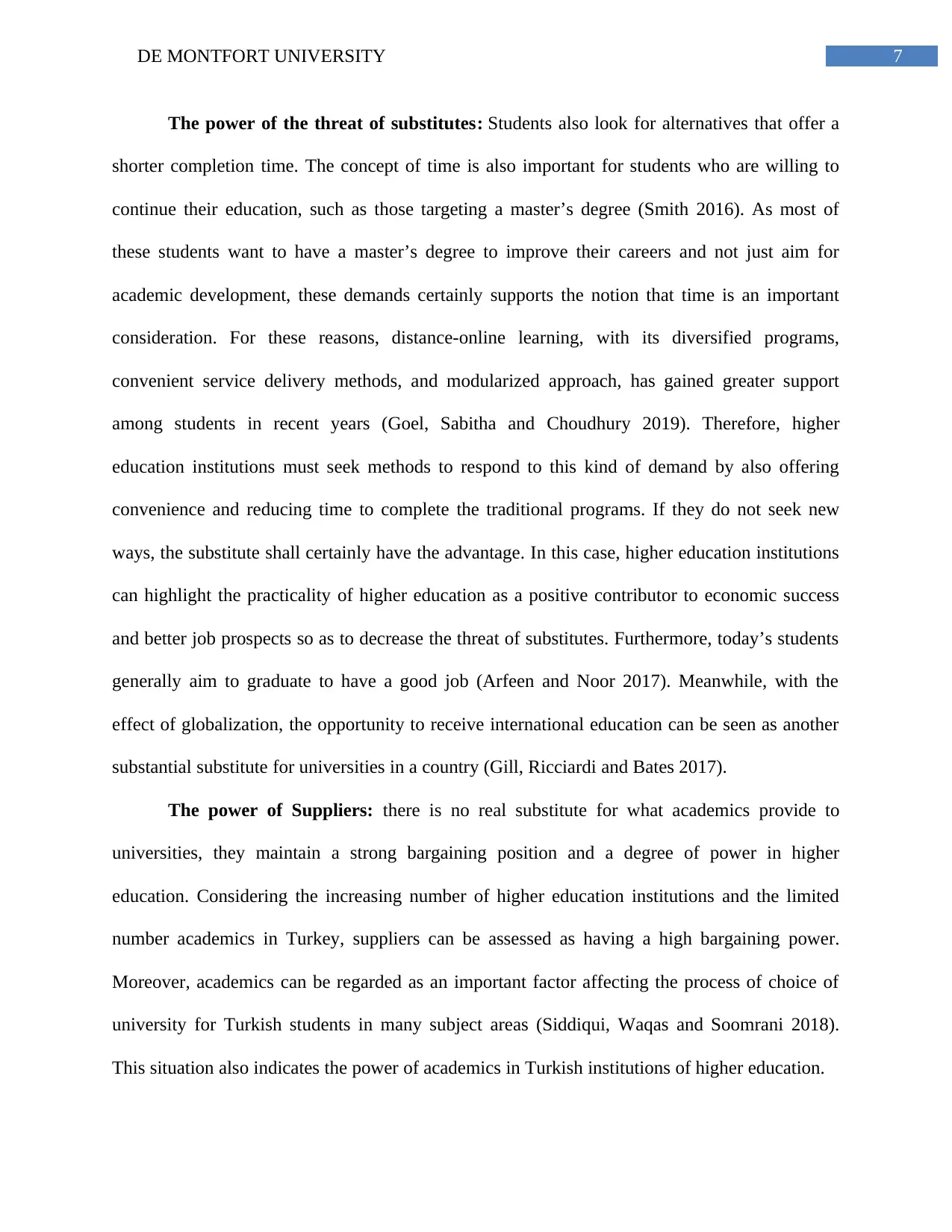
7DE MONTFORT UNIVERSITY
The power of the threat of substitutes: Students also look for alternatives that offer a
shorter completion time. The concept of time is also important for students who are willing to
continue their education, such as those targeting a master’s degree (Smith 2016). As most of
these students want to have a master’s degree to improve their careers and not just aim for
academic development, these demands certainly supports the notion that time is an important
consideration. For these reasons, distance-online learning, with its diversified programs,
convenient service delivery methods, and modularized approach, has gained greater support
among students in recent years (Goel, Sabitha and Choudhury 2019). Therefore, higher
education institutions must seek methods to respond to this kind of demand by also offering
convenience and reducing time to complete the traditional programs. If they do not seek new
ways, the substitute shall certainly have the advantage. In this case, higher education institutions
can highlight the practicality of higher education as a positive contributor to economic success
and better job prospects so as to decrease the threat of substitutes. Furthermore, today’s students
generally aim to graduate to have a good job (Arfeen and Noor 2017). Meanwhile, with the
effect of globalization, the opportunity to receive international education can be seen as another
substantial substitute for universities in a country (Gill, Ricciardi and Bates 2017).
The power of Suppliers: there is no real substitute for what academics provide to
universities, they maintain a strong bargaining position and a degree of power in higher
education. Considering the increasing number of higher education institutions and the limited
number academics in Turkey, suppliers can be assessed as having a high bargaining power.
Moreover, academics can be regarded as an important factor affecting the process of choice of
university for Turkish students in many subject areas (Siddiqui, Waqas and Soomrani 2018).
This situation also indicates the power of academics in Turkish institutions of higher education.
The power of the threat of substitutes: Students also look for alternatives that offer a
shorter completion time. The concept of time is also important for students who are willing to
continue their education, such as those targeting a master’s degree (Smith 2016). As most of
these students want to have a master’s degree to improve their careers and not just aim for
academic development, these demands certainly supports the notion that time is an important
consideration. For these reasons, distance-online learning, with its diversified programs,
convenient service delivery methods, and modularized approach, has gained greater support
among students in recent years (Goel, Sabitha and Choudhury 2019). Therefore, higher
education institutions must seek methods to respond to this kind of demand by also offering
convenience and reducing time to complete the traditional programs. If they do not seek new
ways, the substitute shall certainly have the advantage. In this case, higher education institutions
can highlight the practicality of higher education as a positive contributor to economic success
and better job prospects so as to decrease the threat of substitutes. Furthermore, today’s students
generally aim to graduate to have a good job (Arfeen and Noor 2017). Meanwhile, with the
effect of globalization, the opportunity to receive international education can be seen as another
substantial substitute for universities in a country (Gill, Ricciardi and Bates 2017).
The power of Suppliers: there is no real substitute for what academics provide to
universities, they maintain a strong bargaining position and a degree of power in higher
education. Considering the increasing number of higher education institutions and the limited
number academics in Turkey, suppliers can be assessed as having a high bargaining power.
Moreover, academics can be regarded as an important factor affecting the process of choice of
university for Turkish students in many subject areas (Siddiqui, Waqas and Soomrani 2018).
This situation also indicates the power of academics in Turkish institutions of higher education.
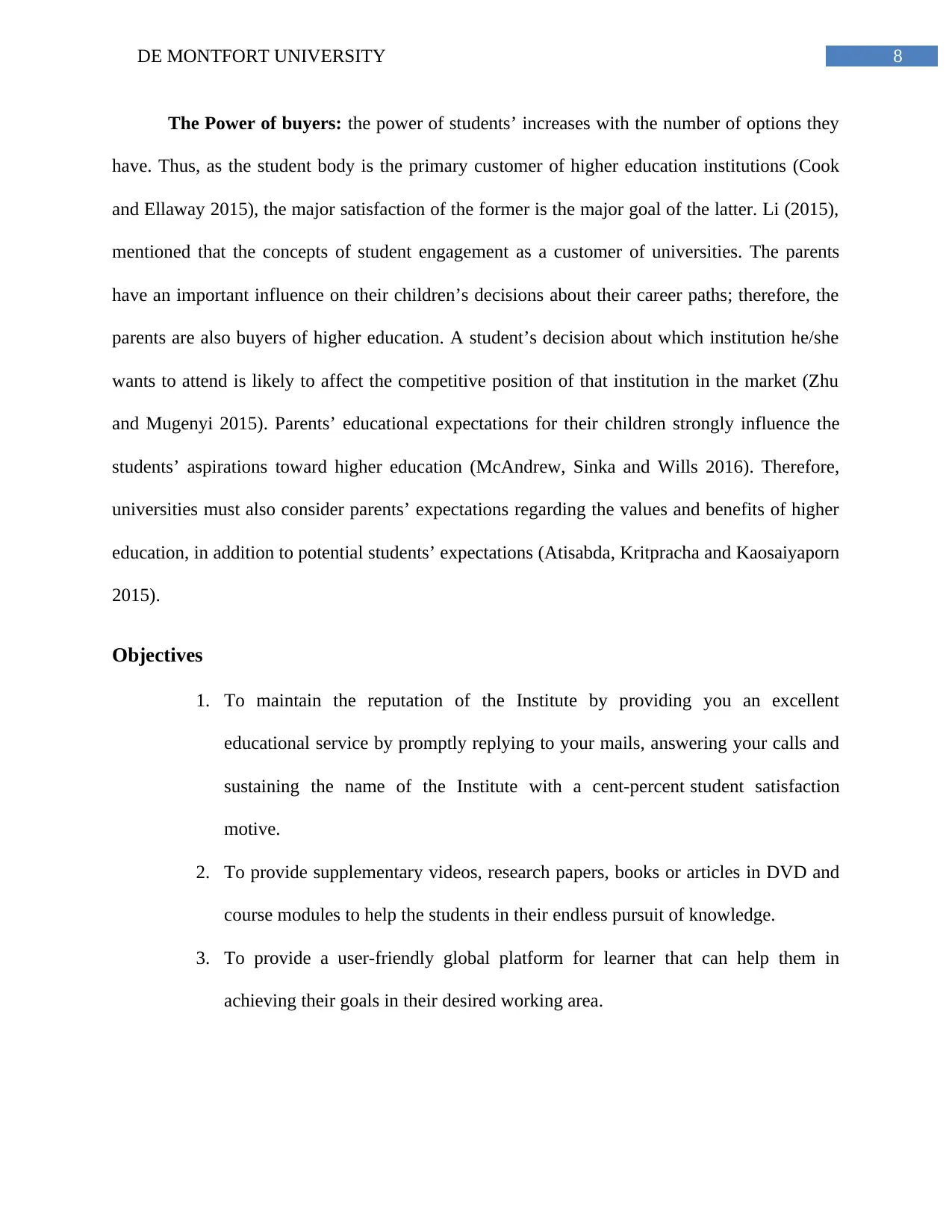
8DE MONTFORT UNIVERSITY
The Power of buyers: the power of students’ increases with the number of options they
have. Thus, as the student body is the primary customer of higher education institutions (Cook
and Ellaway 2015), the major satisfaction of the former is the major goal of the latter. Li (2015),
mentioned that the concepts of student engagement as a customer of universities. The parents
have an important influence on their children’s decisions about their career paths; therefore, the
parents are also buyers of higher education. A student’s decision about which institution he/she
wants to attend is likely to affect the competitive position of that institution in the market (Zhu
and Mugenyi 2015). Parents’ educational expectations for their children strongly influence the
students’ aspirations toward higher education (McAndrew, Sinka and Wills 2016). Therefore,
universities must also consider parents’ expectations regarding the values and benefits of higher
education, in addition to potential students’ expectations (Atisabda, Kritpracha and Kaosaiyaporn
2015).
Objectives
1. To maintain the reputation of the Institute by providing you an excellent
educational service by promptly replying to your mails, answering your calls and
sustaining the name of the Institute with a cent-percent student satisfaction
motive.
2. To provide supplementary videos, research papers, books or articles in DVD and
course modules to help the students in their endless pursuit of knowledge.
3. To provide a user-friendly global platform for learner that can help them in
achieving their goals in their desired working area.
The Power of buyers: the power of students’ increases with the number of options they
have. Thus, as the student body is the primary customer of higher education institutions (Cook
and Ellaway 2015), the major satisfaction of the former is the major goal of the latter. Li (2015),
mentioned that the concepts of student engagement as a customer of universities. The parents
have an important influence on their children’s decisions about their career paths; therefore, the
parents are also buyers of higher education. A student’s decision about which institution he/she
wants to attend is likely to affect the competitive position of that institution in the market (Zhu
and Mugenyi 2015). Parents’ educational expectations for their children strongly influence the
students’ aspirations toward higher education (McAndrew, Sinka and Wills 2016). Therefore,
universities must also consider parents’ expectations regarding the values and benefits of higher
education, in addition to potential students’ expectations (Atisabda, Kritpracha and Kaosaiyaporn
2015).
Objectives
1. To maintain the reputation of the Institute by providing you an excellent
educational service by promptly replying to your mails, answering your calls and
sustaining the name of the Institute with a cent-percent student satisfaction
motive.
2. To provide supplementary videos, research papers, books or articles in DVD and
course modules to help the students in their endless pursuit of knowledge.
3. To provide a user-friendly global platform for learner that can help them in
achieving their goals in their desired working area.
⊘ This is a preview!⊘
Do you want full access?
Subscribe today to unlock all pages.

Trusted by 1+ million students worldwide
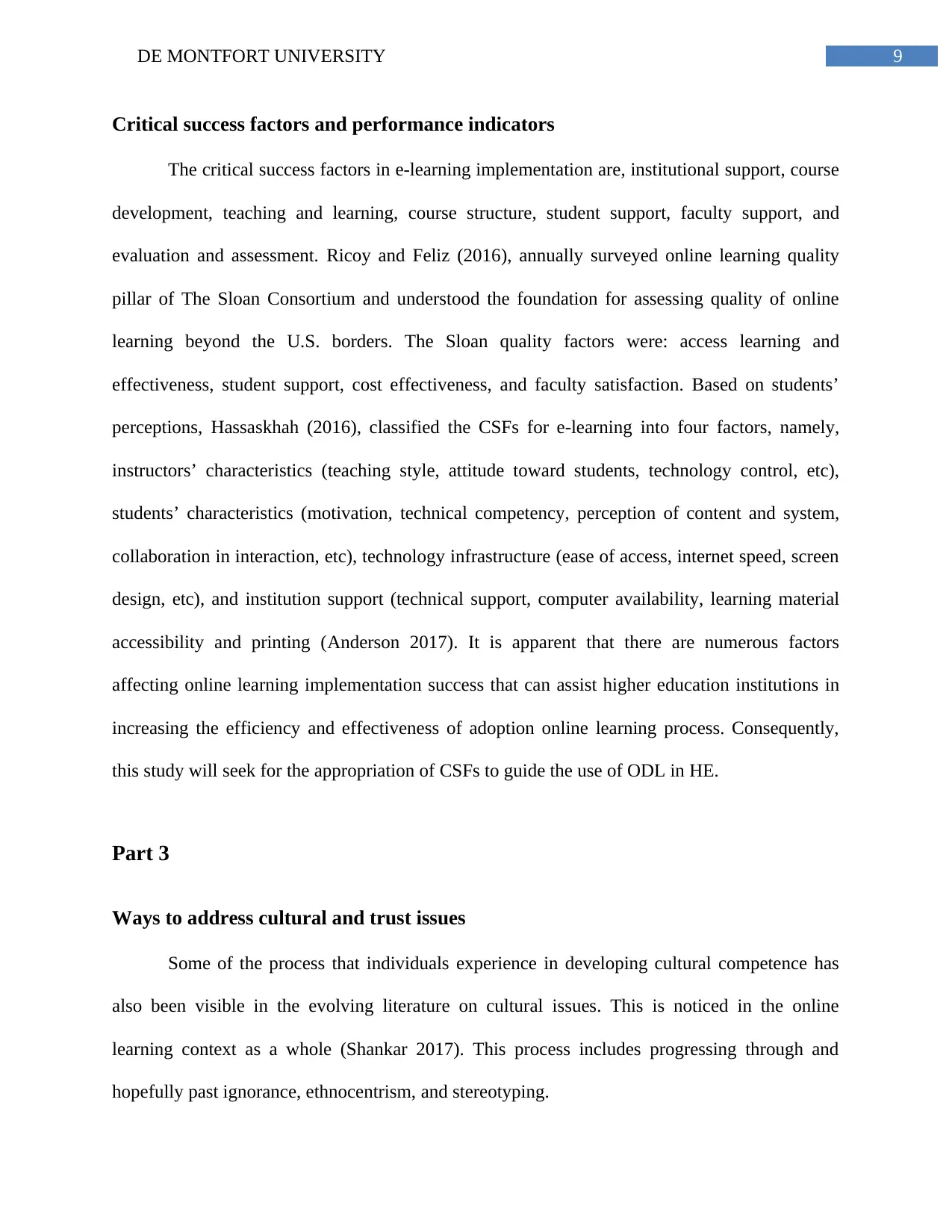
9DE MONTFORT UNIVERSITY
Critical success factors and performance indicators
The critical success factors in e-learning implementation are, institutional support, course
development, teaching and learning, course structure, student support, faculty support, and
evaluation and assessment. Ricoy and Feliz (2016), annually surveyed online learning quality
pillar of The Sloan Consortium and understood the foundation for assessing quality of online
learning beyond the U.S. borders. The Sloan quality factors were: access learning and
effectiveness, student support, cost effectiveness, and faculty satisfaction. Based on students’
perceptions, Hassaskhah (2016), classified the CSFs for e-learning into four factors, namely,
instructors’ characteristics (teaching style, attitude toward students, technology control, etc),
students’ characteristics (motivation, technical competency, perception of content and system,
collaboration in interaction, etc), technology infrastructure (ease of access, internet speed, screen
design, etc), and institution support (technical support, computer availability, learning material
accessibility and printing (Anderson 2017). It is apparent that there are numerous factors
affecting online learning implementation success that can assist higher education institutions in
increasing the efficiency and effectiveness of adoption online learning process. Consequently,
this study will seek for the appropriation of CSFs to guide the use of ODL in HE.
Part 3
Ways to address cultural and trust issues
Some of the process that individuals experience in developing cultural competence has
also been visible in the evolving literature on cultural issues. This is noticed in the online
learning context as a whole (Shankar 2017). This process includes progressing through and
hopefully past ignorance, ethnocentrism, and stereotyping.
Critical success factors and performance indicators
The critical success factors in e-learning implementation are, institutional support, course
development, teaching and learning, course structure, student support, faculty support, and
evaluation and assessment. Ricoy and Feliz (2016), annually surveyed online learning quality
pillar of The Sloan Consortium and understood the foundation for assessing quality of online
learning beyond the U.S. borders. The Sloan quality factors were: access learning and
effectiveness, student support, cost effectiveness, and faculty satisfaction. Based on students’
perceptions, Hassaskhah (2016), classified the CSFs for e-learning into four factors, namely,
instructors’ characteristics (teaching style, attitude toward students, technology control, etc),
students’ characteristics (motivation, technical competency, perception of content and system,
collaboration in interaction, etc), technology infrastructure (ease of access, internet speed, screen
design, etc), and institution support (technical support, computer availability, learning material
accessibility and printing (Anderson 2017). It is apparent that there are numerous factors
affecting online learning implementation success that can assist higher education institutions in
increasing the efficiency and effectiveness of adoption online learning process. Consequently,
this study will seek for the appropriation of CSFs to guide the use of ODL in HE.
Part 3
Ways to address cultural and trust issues
Some of the process that individuals experience in developing cultural competence has
also been visible in the evolving literature on cultural issues. This is noticed in the online
learning context as a whole (Shankar 2017). This process includes progressing through and
hopefully past ignorance, ethnocentrism, and stereotyping.
Paraphrase This Document
Need a fresh take? Get an instant paraphrase of this document with our AI Paraphraser
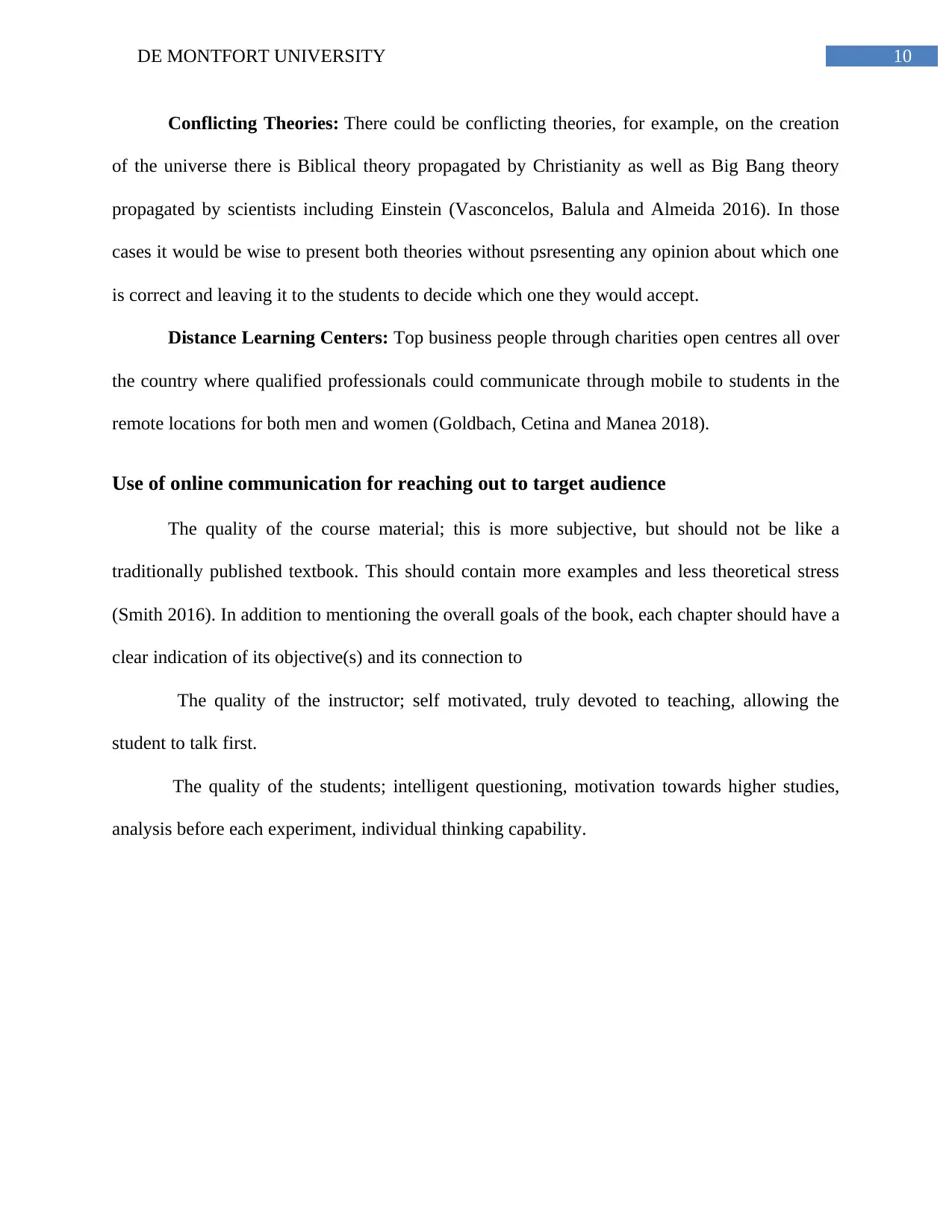
10DE MONTFORT UNIVERSITY
Conflicting Theories: There could be conflicting theories, for example, on the creation
of the universe there is Biblical theory propagated by Christianity as well as Big Bang theory
propagated by scientists including Einstein (Vasconcelos, Balula and Almeida 2016). In those
cases it would be wise to present both theories without psresenting any opinion about which one
is correct and leaving it to the students to decide which one they would accept.
Distance Learning Centers: Top business people through charities open centres all over
the country where qualified professionals could communicate through mobile to students in the
remote locations for both men and women (Goldbach, Cetina and Manea 2018).
Use of online communication for reaching out to target audience
The quality of the course material; this is more subjective, but should not be like a
traditionally published textbook. This should contain more examples and less theoretical stress
(Smith 2016). In addition to mentioning the overall goals of the book, each chapter should have a
clear indication of its objective(s) and its connection to
The quality of the instructor; self motivated, truly devoted to teaching, allowing the
student to talk first.
The quality of the students; intelligent questioning, motivation towards higher studies,
analysis before each experiment, individual thinking capability.
Conflicting Theories: There could be conflicting theories, for example, on the creation
of the universe there is Biblical theory propagated by Christianity as well as Big Bang theory
propagated by scientists including Einstein (Vasconcelos, Balula and Almeida 2016). In those
cases it would be wise to present both theories without psresenting any opinion about which one
is correct and leaving it to the students to decide which one they would accept.
Distance Learning Centers: Top business people through charities open centres all over
the country where qualified professionals could communicate through mobile to students in the
remote locations for both men and women (Goldbach, Cetina and Manea 2018).
Use of online communication for reaching out to target audience
The quality of the course material; this is more subjective, but should not be like a
traditionally published textbook. This should contain more examples and less theoretical stress
(Smith 2016). In addition to mentioning the overall goals of the book, each chapter should have a
clear indication of its objective(s) and its connection to
The quality of the instructor; self motivated, truly devoted to teaching, allowing the
student to talk first.
The quality of the students; intelligent questioning, motivation towards higher studies,
analysis before each experiment, individual thinking capability.
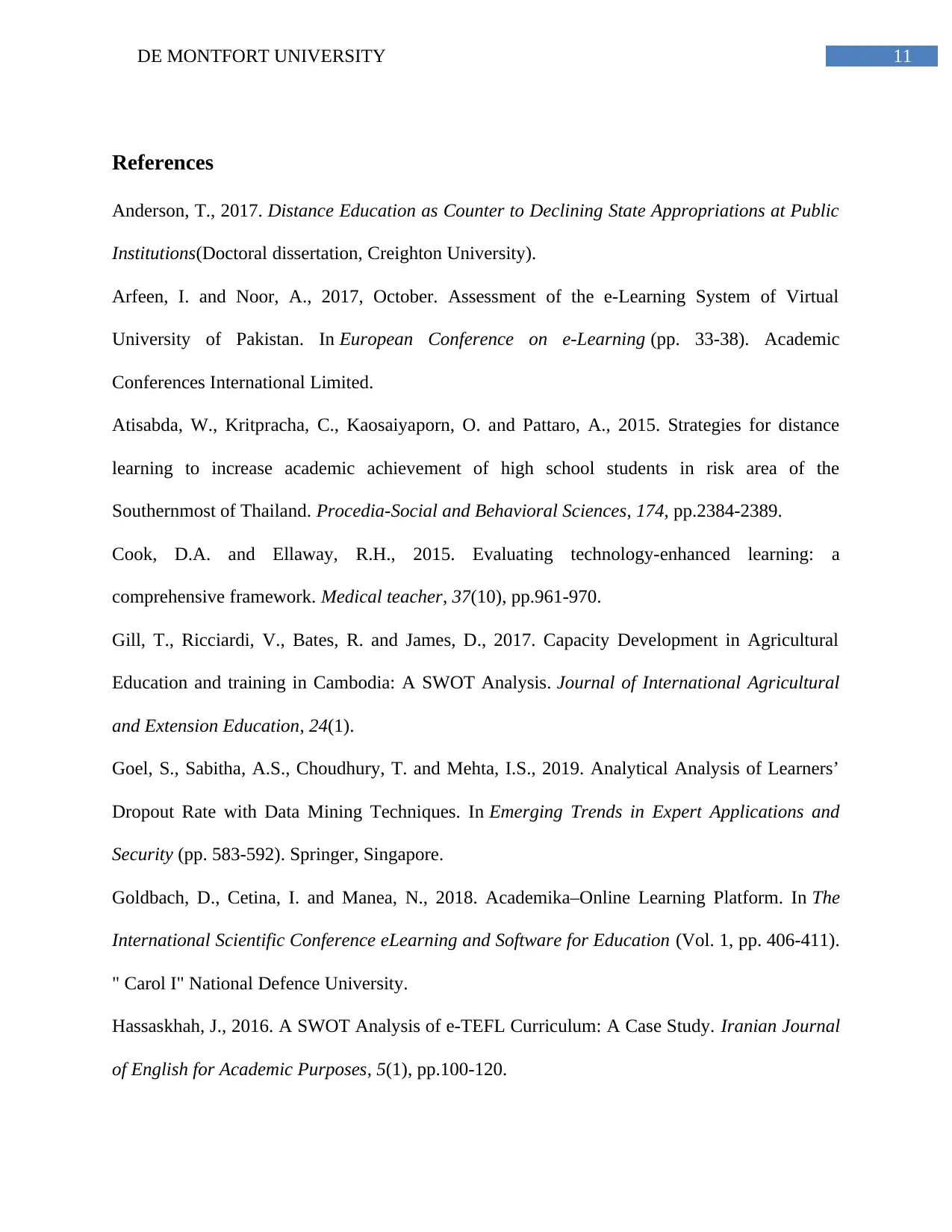
11DE MONTFORT UNIVERSITY
References
Anderson, T., 2017. Distance Education as Counter to Declining State Appropriations at Public
Institutions(Doctoral dissertation, Creighton University).
Arfeen, I. and Noor, A., 2017, October. Assessment of the e-Learning System of Virtual
University of Pakistan. In European Conference on e-Learning (pp. 33-38). Academic
Conferences International Limited.
Atisabda, W., Kritpracha, C., Kaosaiyaporn, O. and Pattaro, A., 2015. Strategies for distance
learning to increase academic achievement of high school students in risk area of the
Southernmost of Thailand. Procedia-Social and Behavioral Sciences, 174, pp.2384-2389.
Cook, D.A. and Ellaway, R.H., 2015. Evaluating technology-enhanced learning: a
comprehensive framework. Medical teacher, 37(10), pp.961-970.
Gill, T., Ricciardi, V., Bates, R. and James, D., 2017. Capacity Development in Agricultural
Education and training in Cambodia: A SWOT Analysis. Journal of International Agricultural
and Extension Education, 24(1).
Goel, S., Sabitha, A.S., Choudhury, T. and Mehta, I.S., 2019. Analytical Analysis of Learners’
Dropout Rate with Data Mining Techniques. In Emerging Trends in Expert Applications and
Security (pp. 583-592). Springer, Singapore.
Goldbach, D., Cetina, I. and Manea, N., 2018. Academika–Online Learning Platform. In The
International Scientific Conference eLearning and Software for Education (Vol. 1, pp. 406-411).
" Carol I" National Defence University.
Hassaskhah, J., 2016. A SWOT Analysis of e-TEFL Curriculum: A Case Study. Iranian Journal
of English for Academic Purposes, 5(1), pp.100-120.
References
Anderson, T., 2017. Distance Education as Counter to Declining State Appropriations at Public
Institutions(Doctoral dissertation, Creighton University).
Arfeen, I. and Noor, A., 2017, October. Assessment of the e-Learning System of Virtual
University of Pakistan. In European Conference on e-Learning (pp. 33-38). Academic
Conferences International Limited.
Atisabda, W., Kritpracha, C., Kaosaiyaporn, O. and Pattaro, A., 2015. Strategies for distance
learning to increase academic achievement of high school students in risk area of the
Southernmost of Thailand. Procedia-Social and Behavioral Sciences, 174, pp.2384-2389.
Cook, D.A. and Ellaway, R.H., 2015. Evaluating technology-enhanced learning: a
comprehensive framework. Medical teacher, 37(10), pp.961-970.
Gill, T., Ricciardi, V., Bates, R. and James, D., 2017. Capacity Development in Agricultural
Education and training in Cambodia: A SWOT Analysis. Journal of International Agricultural
and Extension Education, 24(1).
Goel, S., Sabitha, A.S., Choudhury, T. and Mehta, I.S., 2019. Analytical Analysis of Learners’
Dropout Rate with Data Mining Techniques. In Emerging Trends in Expert Applications and
Security (pp. 583-592). Springer, Singapore.
Goldbach, D., Cetina, I. and Manea, N., 2018. Academika–Online Learning Platform. In The
International Scientific Conference eLearning and Software for Education (Vol. 1, pp. 406-411).
" Carol I" National Defence University.
Hassaskhah, J., 2016. A SWOT Analysis of e-TEFL Curriculum: A Case Study. Iranian Journal
of English for Academic Purposes, 5(1), pp.100-120.
⊘ This is a preview!⊘
Do you want full access?
Subscribe today to unlock all pages.

Trusted by 1+ million students worldwide
1 out of 13
Your All-in-One AI-Powered Toolkit for Academic Success.
+13062052269
info@desklib.com
Available 24*7 on WhatsApp / Email
![[object Object]](/_next/static/media/star-bottom.7253800d.svg)
Unlock your academic potential
Copyright © 2020–2025 A2Z Services. All Rights Reserved. Developed and managed by ZUCOL.

